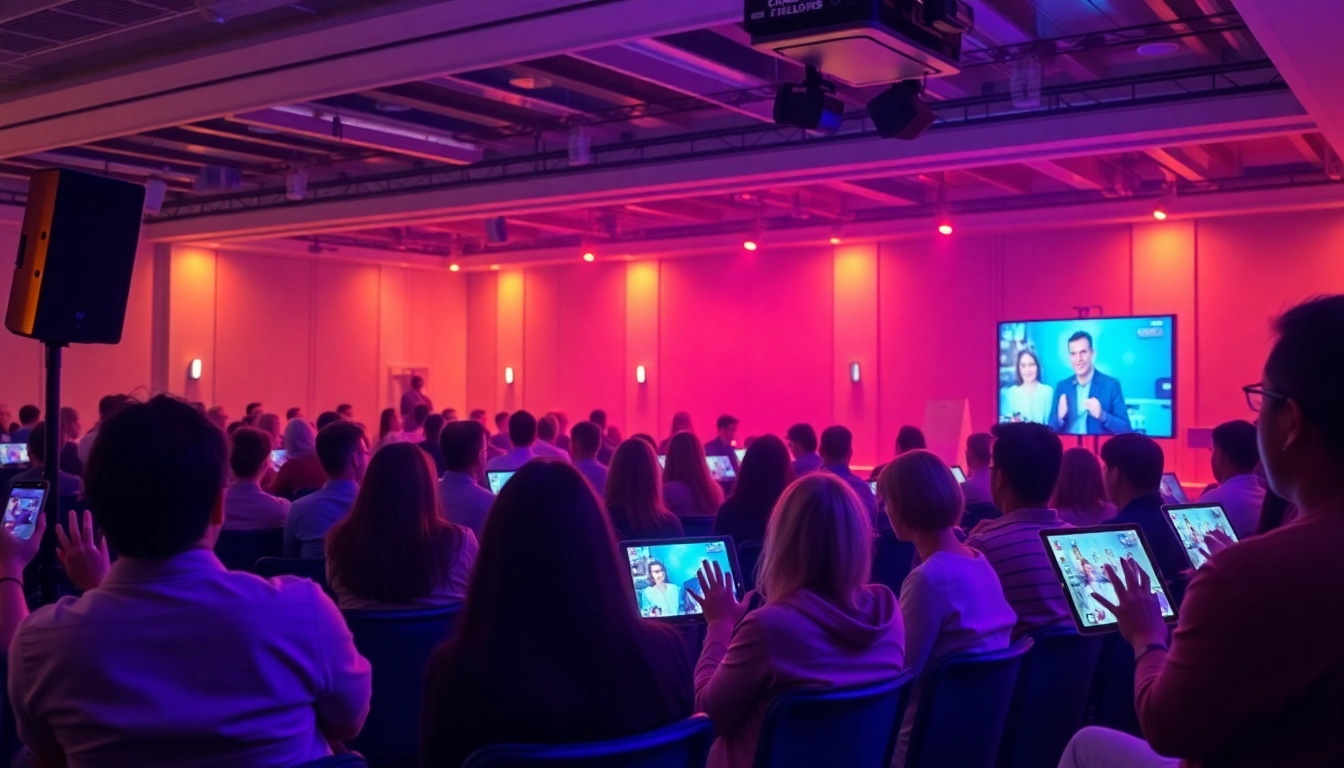Understanding the Virtual Audience System
What is a Virtual Audience System?
A Virtual Audience System (VAS) is an innovative technological solution designed to bridge the gap between live events and remote participants. In today’s digital age, where audiences may be scattered across the globe, this system allows event organizers to create immersive experiences that engage virtual participants as if they were physically present. A VAS encompasses a suite of tools and platforms that facilitate real-time interaction, feedback, and participation during live events, from webinars and conferences to concerts and trade shows. By utilizing a Virtual Audience System, event planners can enhance attendee experiences, drive deeper engagement, and gather valuable insights into audience behaviors and preferences.
Key Components of a Virtual Audience System
Successful implementation of a Virtual Audience System comprises several essential components:
- Live Streaming Technology: Enables high-quality video and audio transmission to ensure that remote audience members can see and hear the event clearly.
- Interactive Tools: Includes features such as chat, polls, Q&A sessions, and feedback forms that allow participants to engage actively with presenters and other attendees.
- User Interface: A well-designed dashboard that facilitates easy navigation for both the audience and event hosts, ensuring a seamless experience.
- Analytics and Reporting: Tools that provide data on audience engagement, participation rates, and event effectiveness, enabling organizers to refine future events.
- Integration Capabilities: Ability to connect with existing event platforms and software, making it easier for organizers to consolidate their efforts.
Benefits of a Virtual Audience System for Live Events
Adopting a Virtual Audience System can unlock a multitude of benefits for live events:
- Extended Reach: The ability to connect with audiences worldwide, crossing geographical barriers and enabling greater attendance.
- Increased Engagement: Interactive features foster a sense of community and participation, making audiences feel more involved.
- Cost Efficiency: Reduces costs associated with travel, venue hire, and other logistics, allowing organizers to allocate resources more effectively.
- Data-Driven Insights: The ability to collect and analyze engagement metrics helps organizers tailor future events to better meet audience needs.
- Flexibility: Virtual systems allow for adjustments in real-time, accommodating unforeseen circumstances such as technical issues or changes in audience dynamics.
Setting Up Your Virtual Audience System
Choosing the Right Technology
The first step to a successful Virtual Audience System is selecting the appropriate technology. Key factors to consider include:
- Scalability: The chosen technology should accommodate a growing audience, allowing for easy upgrades or expansions as needed.
- Integration: Ensure compatibility with existing tools and platforms, such as CRM software and email marketing systems.
- User Experience: Select technology that provides a user-friendly interface for both organizers and attendees.
- Support and Maintenance: Choose a provider that offers reliable technical support and ongoing maintenance to minimize disruptions during events.
Step-by-Step Setup Guide
Setting up a Virtual Audience System requires careful planning and execution. Here’s a detailed step-by-step guide:
- Define Your Objectives: Clearly outline what you hope to achieve with your virtual audience system, including audience engagement goals and feedback collection methods.
- Select the Right Platform: Choose a platform that aligns with your defined objectives—whether it’s Zoom, Microsoft Teams, or a more specialized event platform.
- Test Your Equipment: Conduct thorough testing of all audio/visual equipment, internet connections, and hardware to ensure seamless functioning during the event.
- Design Your Event Content: Create an engaging agenda that incorporates interactive features, effective pacing, and a variety of presentation styles to keep the audience interested.
- Train Your Team: Ensure that all team members are comfortable using the technology and know their roles during the live event to prevent confusion.
- Promote Your Event: Utilize social media, newsletters, and other marketing channels to build excitement and attract a larger audience.
- Conduct a Dry Run: Run a rehearsal to troubleshoot potential issues and refine the flow of the event before the actual date.
Integration with Existing Event Platforms
To maximize the effectiveness of your virtual audience system, it’s crucial to integrate it with existing event management platforms. This integration can simplify registration processes, enhance user experience, and facilitate data collection. Here are key points to consider:
- Single Sign-On (SSO): Implement SSO capabilities to enable easier access for users across different platforms.
- Registration and Ticketing: Connect your virtual system with registration platforms to streamline attendee check-in and ticket validation.
- CRM Integration: Synchronize attendee data with your Customer Relationship Management (CRM) system for better follow-up and engagement post-event.
- Marketing Automation: Use marketing automation tools to nurture and engage attendees before and after the event through personalized communication.
Engaging Strategies for Virtual Audiences
Interactive Tools and Features
To enhance engagement during virtual events, implementing interactive tools and features is essential. Here are some effective options:
- Live Polls: Use live polling to gather instant feedback from participants on topics discussed, which can lead to more tailored content within the event.
- Q&A Sessions: Allocate time for audience questions, allowing participants to actively contribute to discussions, fostering a more inclusive environment.
- Breakout Rooms: Encourage networking and focused discussions by utilizing breakout rooms for smaller group interactions.
- Gamification: Incorporate quizzes and challenges related to event content to keep audiences motivated and engaged.
Best Practices for Audience Participation
Maximizing audience participation involves implementing best practices. Consider the following strategies:
- Clear Instructions: Provide clear and concise instructions for all interactive components to ensure participants know how to engage effectively.
- Encourage Multichannel Engagement: Utilize various platforms (social media, chat functions) to reduce reliance on a single communication channel.
- Personalize Engagement: Address audience members by name when responding to questions or comments to foster a sense of connection and recognition.
- Follow-up Engagement: After the event, send thank-you notes and surveys to gather feedback and maintain a relationship with attendees.
Case Studies of Successful Engagement
Numerous organizations have successfully implemented Virtual Audience Systems to enhance engagement. Here are two notable case studies:
Case Study 1: TechWorld Conference
TechWorld Conference seamlessly integrated a Virtual Audience System that included live Q&A, polls, and virtual networking rooms. The result was a 60% increase in attendee engagement compared to previous years, with over 85% of participants reporting satisfaction in post-event surveys.
Case Study 2: Annual Music Festival
A global music festival used a Virtual Audience System to bring together fans remotely. By offering interactive features such as voting for setlists and exclusive backstage access, they increased their audience size by 150%, demonstrating the effectiveness of virtual engagement strategies.
Measuring the Success of Your Virtual Audience System
Key Performance Indicators (KPIs)
Measuring the success of your Virtual Audience System requires tracking specific key performance indicators (KPIs). Here are some important KPIs to consider:
- Attendance Rates: Track the number of participants against registrations to assess audience interest and engagement levels.
- Engagement Metrics: Analyze interactions such as chat messages, poll responses, and average session duration to gauge audience participation.
- Feedback Scores: Utilize post-event surveys to collect participant feedback and calculate overall event satisfaction ratings.
- Return on Investment (ROI): Evaluate the cost versus benefits achieved through the virtual event, including sponsorship revenue and attendee subscriptions.
Feedback Collection Techniques
Collecting feedback is pivotal in improving future events. Effective techniques include:
- Post-Event Surveys: Distribute comprehensive surveys that allow attendees to share their thoughts on various aspects of the event.
- Live Feedback Tools: Use real-time feedback tools during the event to gauge audience reactions instantly.
- Social Media Monitoring: Monitor mentions and comments across social media platforms to gather qualitative insights into audience experiences.
Analyzing Engagement Data
Analyzing the engagement data collected post-event helps identify trends and areas for improvement:
- Identify Engagement Peaks: Look for times when audience interaction was highest to understand which segments resonated most with attendees.
- Segment Feedback: Analyze feedback by demographic or interest group to tailor future events to specific audience segments.
- Compare Across Events: Measure performance against previous events to assess growth and set benchmarks for future improvements.
Future Trends in Virtual Audience Systems
Evolving Technologies for Live Events
The landscape of virtual audience systems is expected to continue evolving with advancements in technology. Future trends may include:
- Enhanced Virtual Reality (VR) and Augmented Reality (AR): As VR and AR technologies advance, they will offer more immersive experiences, allowing participants to interact with the event environment in innovative ways.
- Artificial Intelligence for Personalization: Leveraging AI to analyze data in real-time will enable event organizers to tailor content and engagement strategies to individual preferences.
- Integration of 5G Technology: The rollout of 5G will enhance streaming quality and reduce latency, providing a smoother experience for remote attendees.
User Expectations in Virtual Engagement
As virtual events become commonplace, user expectations will continue to evolve. Key considerations include:
- Demand for Interactivity: Audiences will increasingly expect interactive features and opportunities for dialogue with speakers.
- Quality Content: Providing high-quality, relevant content will remain paramount in attracting and retaining virtual attendees.
- Accessible Technologies: Ensuring accessibility features for all users will be a significant factor in engagement, as audiences value inclusivity.
Preparing for Future Developments
To remain competitive, organizations must be proactive in preparing for future developments in virtual audience systems:
- Stay Updated on Technological Advancements: Regularly assess emerging technologies and how they can be integrated into existing virtual systems.
- Invest in Training: Ensure that your team is well-versed in new technologies and methodologies to effectively engage audiences.
- Continuously Iterate: Use insights from previous events to make ongoing improvements, adapting to changing audience needs and preferences.























+ There are no comments
Add yours